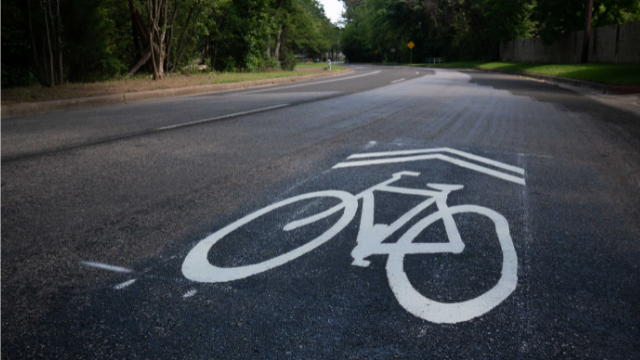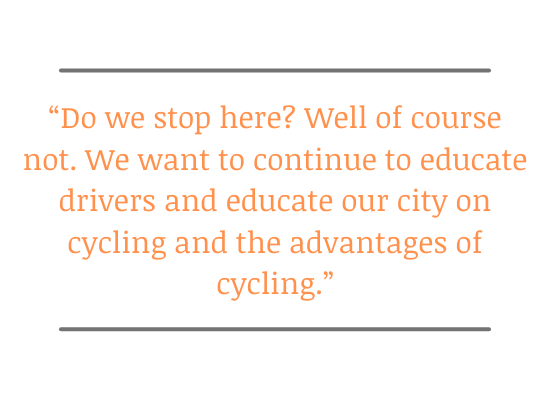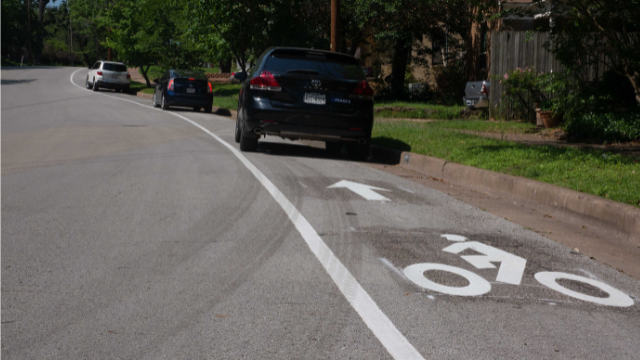Tylerites have new ways to navigate across the city thanks to about 36 miles of bike lane additions inside and outside Loop 323, set to be completed around July or August.
The infrastructure updates include painted bike lanes, designated bike path signage and shared bike/car lanes across north and south Tyler as well as downtown. City officials and local riders hope the new routes will allow cyclists to reach their target destinations with greater ease.

“Bicycles have always been able to share the road with motorists. That hasn’t changed,” Tyler traffic engineer Cameron Williams said. “[The project] is increasing those opportunities to cyclists to give them a designated spot on the roadway where they can travel and hopefully encourage cyclists to be out there more and make motorists more aware that they’re present.”
Research and development for Tyler’s newest bike plan began in 2015, when TxDOT advisory committee members approached UT Tyler’s engineering department to design new cycling routes.
A 2017 TxDOT grant secured funding for 80 percent of the project’s planning and construction cost. City funds and donations from UT Tyler and local organizations contributed to the other 20 percent, for a total price tag of $544,541.37.
The Tyler Area Metropolitan Planning Organization outlined proposed bike network updates and route planning methodology in their 2019 Active Tyler Transportation Plan. The plan surveyed existing transportation infrastructure within Tyler and neighboring cities, then introduced ideas for a safer and more extensive cycling and walking network.
Planners considered traffic volumes, speed limits, street width and elevation when drawing new routes, with special consideration paid toward connecting Tyler’s colleges and universities. The final product forms a “hub and spoke” configuration of bike routes extending out of downtown toward neighborhoods and destinations.

“A lot of the goal was to provide connectivity to different destinations that people would want to go to,” Williams said. “Maybe you’re going from UT Tyler to downtown, or maybe from the northern part of the city to downtown — different origins and destinations people would really like to go.”
Tyler’s bike routes appear in three separate forms: painted stripes, shared lanes between bikes and cars called “sharrows” and bike routes denoted by signs but no road markings. Planners determined the kind of markings to use based on factors like street width. Some routes transition between different kinds of lanes as well.
Before the new additions, Tyler had some existing bike routes and lanes but not many bike commuters. As a car-oriented city, biking through Tyler also may present a challenge to more untrained riders who will have to contend with motorists in shared lanes or places with no designated bike route.
For longtime cyclist Jonathan Ramm who makes bike deliveries within Tyler for Porch Culture Coffee, a more bikeable Tyler is a breath of fresh air.
“These stripes feel like getting a hug from the city of Tyler,” Ramm said. “One of the roads that I’ve ridden on for as long as our business has been running, for the last eight or nine years, had stripes on it…. I had this sense of ‘It’s okay to do this here.’”
Ramm said his “addiction” to biking began during his high school years in Tyler, then continued into his adult life while living in the Dominican Republic, a more bike-oriented country. But cycling culture plays a less prominent role in East Texas, where riding a bike seems like either not an option or an activity for only the most hardcore cyclist, Ramm said.
“There are lots of people that would be similar to me that aren’t like high performance athletes, where this is a really fun alternative way to get around,” Ramm said. And I think if it could just be more socially acceptable to use a bike for transportation, the economic impact of that is huge on people that don’t have as much money.”
Not every commuter cyclist in Tyler sees the new stripes as effective, however. Aristeo Rodriguez, former worker at Tyler bike shop Elite Bicycles, said current Tyler biking conditions do not adequately connect the whole city.
“With true commuting and truly using the bicycle as a vehicle, the town infrastructure just isn’t very good,” Rodriguez said. “In other cities, you have better routes and crossings. The proposed bike lanes aren’t very good at all. They start and finish at nothing… I shouldn’t have to jump in my truck to drive across town to feel like I can ride my bike safely.”
Without many commuters, Tyler also faces a lack of bike racks at businesses and destinations for cyclists to safely lock up bikes. Rodriguez and other riders said they are looking forward to a culture shift in Tyler.
“The younger crowd wants to [ride bikes],” Rodriguez said. “I think they choose not to because it’s super sketchy to ride in town.”

Tyler hosted public hearings and considered citizen input on the project before approving the final plan. Common concerns included route placement and cyclist safety, but especially potential restrictions on parking created by bike lanes.

City officials assured residents that street parking and trash bin placement would not face restrictions on streets with painted lanes. As a result, cars interrupt bike lanes, forcing cyclists to also ride with car traffic to avoid obstacles.
“Cyclists need to be aware of their surroundings,” Lou Ann Campbell, public information officer for Tyler public works and facilities, said via email. “If a bicycle lane is occupied by a parked car, trash can or other object, the cyclist should look for traffic and move into the roadway when it is safe and ride around the object or obstruction that is in the bicycle lane.”
Addressing reports of criticism from Tylerites about narrowing car lanes, Tyler Bicycle Club president Bill Lewis said residents need time to adjust to more recognition of local cyclists.
“Having a bike lane is absolutely a first step in establishing cycling as a legitimate form not only of recreation, but also of transportation,” Lewis said. “Do we stop here? Well of course not. We want to continue to educate drivers and educate our city on cycling and the advantages of cycling.”

The current lanes may see more future improvements according to proposals within the Active Tyler Transportation Plan. Planners envision adding more bike lanes in and around Tyler, and creating lanes dedicated only for cycling, separated from car traffic.
Creating better bike infrastructure will take effort from more than just cyclists, Lewis said.
“At times people are like ‘I will never ride my bike in Tyler with the drivers,’” Lewis said. “If you don’t, then your kids are never going to get a chance to do it either. The city has shown us that they’re open. They’ve made the bike lanes, and now it’s up to us to begin to use those and to begin to show people that it is a protected, dedicated space for cycling and running.”
Love what you're seeing in our posts? Help power our local, nonprofit journalism platform — from in-depth reads, to freelance training, to COVID Stories videos, to intimate portraits of East Texans through storytelling.
Our readers have told us they want to better understand this place we all call home, from Tyler's north-south divide to our city's changing demographics. What systemic issues need attention? What are are greatest concerns and hopes? What matters most to Tylerites and East Texans?
Help us create more informed, more connected, more engaged Tyler. Help us continue providing no paywall, free access posts. Become a member today. Your $15/month contribution drives our work.







